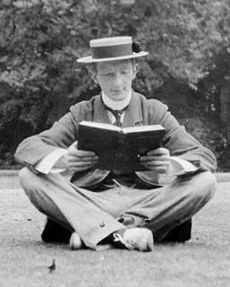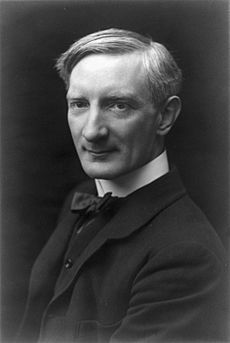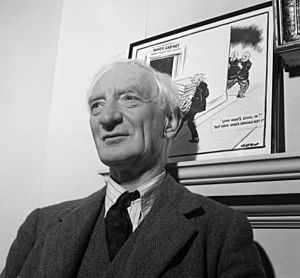William Beveridge facts for kids
Quick facts for kids
The Lord Beveridge
|
|
|---|---|
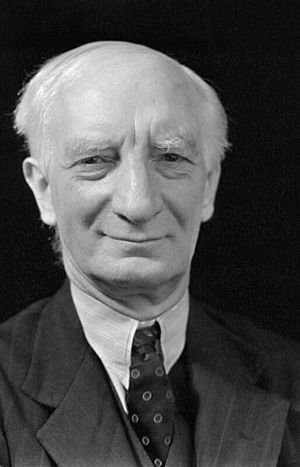 |
|
| Member of Parliament for Berwick-upon-Tweed |
|
| In office 17 October 1944 – 15 June 1945 |
|
| Preceded by | George Charles Grey |
| Succeeded by | Robert Thorp |
| Majority | 7,523 (74.8%) |
| Personal details | |
| Born | 5 March 1879 Rangpur City, Bengal, India (now Bangladesh) |
| Died | 16 March 1963 (aged 84) Oxford, England |
| Nationality | British |
| Political party | Liberal |
| Spouse |
Janet Philip
(m. 1942; died 1959) |
| Parents |
|
| Education | Charterhouse School |
| Alma mater | Balliol College, Oxford |
| Occupation |
|
| Known for | Work towards founding the welfare state in the United Kingdom |
William Henry Beveridge, 1st Baron Beveridge (born March 5, 1879 – died March 16, 1963) was an important British economist and politician. He was a member of the Liberal Party. Beveridge is famous for helping to create the modern welfare state in the United Kingdom.
His most well-known work is the 1942 report called Social Insurance and Allied Services. This report is often called the Beveridge Report. It became the foundation for the welfare state that the Labour government set up in 1945.
Beveridge was an expert on unemployment insurance. He worked for the government, helping to set up new labour exchanges. These places helped people find jobs. He also led the London School of Economics from 1919 to 1937. Later, he became the Master of University College, Oxford.
He wrote many books about unemployment and social security. Some of his important books include Unemployment: A Problem of Industry (1909) and Full Employment in a Free Society (1944). He was elected as a Liberal Member of Parliament (MP) in 1944. After losing his seat in 1945, he became a member of the House of Lords. There, he led the Liberal politicians.
Contents
Early Life and School Days
William Beveridge was born in Rangpur, British India (now Rangpur, Bangladesh) on March 5, 1879. He was the oldest son of Henry Beveridge, who worked for the Indian government, and Annette Ackroyd, a scholar.
His mother, Annette, helped start the Working Women's College in London in 1864. She moved to India in 1873 to open a school for Indian girls. There, she met and married Henry Beveridge.
William went to Charterhouse School, which is a well-known private school in England. After that, he studied Mathematics and Classics at Balliol College at the University of Oxford. He did very well in his studies, earning top grades in both subjects. He also studied law later on.
Beveridge's father was a follower of Auguste Comte, a French philosopher. Comte's ideas about a secular "religion of humanity" influenced Beveridge's family life. These ideas also shaped Beveridge's own thinking throughout his life. He described himself as a "materialist agnostic."
Career and Public Service
After university, Beveridge first worked as a lawyer. He became very interested in social services and wrote about them for a newspaper. His interest in why people were unemployed grew in 1903. This was when he worked at Toynbee Hall, a community center in London.
There, he worked with Sidney Webb and Beatrice Webb. They were important social reformers. Beveridge was influenced by their ideas. He actively supported old age pensions and free school meals. He also campaigned for a national system of labour exchanges. These exchanges would help people find jobs.
By 1908, Beveridge was seen as Britain's top expert on unemployment insurance. Beatrice Webb introduced him to Winston Churchill. Churchill invited Beveridge to join the Board of Trade. Beveridge then helped set up the national system of labour exchanges. He also helped create National Insurance to fight unemployment and poverty.
During the First World War, he helped organize workers for the war effort. After the war, he was knighted. He then became the permanent secretary for the Ministry of Food.
In 1919, he left government service. He became the director of the London School of Economics and Political Science. For many years, he served on committees about social policy. He was greatly influenced by the Fabian Society, especially Beatrice Webb. He published economic works, including his early book on unemployment in 1909.
From 1929, he led an international committee on price history. He wrote a large study called Prices and Wages in England from the Twelfth to the Nineteenth Century (1939). In 1933, he helped create the Council for Assisting Refugee Academics. This group helped academics who were forced to leave their jobs due to Nazi persecution. In 1937, Beveridge became the Master of University College, Oxford.
Work During Wartime
Three years later, Ernest Bevin, the Minister of Labour during wartime, asked Beveridge to lead a department. Beveridge declined this specific role. However, he was very interested in organizing Britain's workforce during the war. He believed in strong central planning.
Bevin was not keen on Beveridge having too much power. But he did ask him to work on a manpower survey in June 1940. So, Beveridge became a temporary civil servant. Neither Bevin nor the Permanent Secretary, Sir Thomas Phillips, found Beveridge easy to work with. They thought he was conceited.
Beveridge's work on manpower led him to chair a committee. This committee reported to the War Cabinet in 1941. Two of its suggestions were put into action. Army recruits were first placed in the General Service Corps. This allowed their skills to be matched with the Army's needs. Also, the Corps of Royal Electrical and Mechanical Engineers was created.
The Beveridge Report and Full Employment
In May 1941, an opportunity arose for Beveridge. The Minister of Health, Ernest Brown, announced a committee. This committee would look at existing social insurance and services. It would also make recommendations. Arthur Greenwood had pushed for this inquiry. Bevin suggested Beveridge as the chairman. Beveridge was not very interested at first. He saw it as a distraction from his manpower work. But he eventually accepted the role.
The report, Social Insurance and Allied Services, was published in November 1942. It suggested that all working-age people should pay a weekly national insurance contribution. In return, people who were sick, unemployed, retired, or widowed would receive benefits. Beveridge said this system would provide a basic living standard. He wanted to ensure "no one should be allowed to fall" below it.
The report recommended that the government fight "five giants" blocking progress. These giants were Want (poverty), Disease, Ignorance, Squalor (poor housing), and Idleness (unemployment). Beveridge also assumed there would be a National Health Service. This was already being planned by the Ministry of Health.
Beveridge's ideas were widely accepted. He convinced people by arguing that welfare would help British industry. It would make workers healthier, wealthier, and more motivated. This would lead to more productive workers. They would also buy more British goods.
Beveridge believed that full employment was key to his social welfare plan. He defined full employment as unemployment of no more than 3%. In his 1944 book, Full Employment in a Free Society, he said it was "absurd" to expect individual employers to keep demand high and ensure full employment. He believed the government should take on this responsibility. Measures to achieve full employment could include government spending and control over the workforce. Beveridge's main goal was social justice. He wanted to create a better society after the war.
Later Political Life
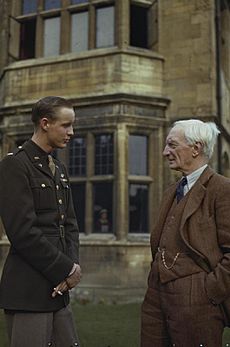
In 1944, Beveridge joined the Liberal Party. He was elected to the House of Commons in a special election. He became the Member of Parliament (MP) for Berwick-upon-Tweed. He was part of a group that wanted the Liberal Party to have more radical policies. However, he lost his seat in the 1945 general election. He was defeated by the Conservative candidate, Robert Thorp.
In that 1945 election, Clement Attlee and the Labour Party won. They defeated Winston Churchill's Conservative Party. The new Labour Government then started to put Beveridge's ideas into action. These ideas formed the basis of the modern Welfare State.
Attlee announced that the Welfare State outlined in the 1942 Beveridge Report would be introduced. This included creating a National Health Service in 1948. This meant taxpayer-funded medical care for everyone. A national system of benefits was also introduced. This "social security" system aimed to protect people "from the cradle to the grave." The new system built upon the National Insurance scheme started in 1911 by David Lloyd George.
In 1946, Beveridge was made a peer. He became Baron Beveridge in the House of Lords. He eventually became the leader of the Liberal Party in the House of Lords. He wrote a book called Power and Influence (1953). He also served as the President of the charity Attend from 1952 to 1962.
Personal Life
In 1942, Beveridge married Janet (Jessy) Thomson Philip. She was a mathematician. They had worked together in government and at the London School of Economics. Janet was very important in helping to write and share the Beveridge Report.
William Beveridge died at his home on March 16, 1963, at the age of 84. He was buried in Thockrington churchyard. His title of Baron ended when he died because he had no children to inherit it. His last words were "I have a thousand things to do."
Remembering William Beveridge
Beveridge Street in Christchurch Central City, New Zealand, was named after William Beveridge. This happened in 1948.
In November 2018, English Heritage placed a blue plaque to honor Beveridge. It is at 27 Bedford Gardens in London. He lived there from 1914 to 1921.
University College, Oxford has a society for students studying Philosophy, Politics, and Economics. This society was recently renamed the Beveridge Society in his honor.
Works
- Unemployment: A problem of industry, 1909. online (Archive.org)
- 'Wages in the Winchester Manors', Economic History Review, Vol. VII, 1936–37.
- Prices and Wages in England from the Twelfth to the Nineteenth Century, 1939.
- Social Insurance and Allied Services, 1942. (The Beveridge Report)
- The Pillars of Security and Other War-Time Essays and Addresses, 1943, republished 2014.
- Full Employment in a Free Society, 1944.
- The Economics of Full Employment, 1944.
- Why I am a Liberal, 1945.
- The Price of Peace, 1945.
- Power and Influence, 1953.
- "India Called Them," George Allen & Unwin, 1947
- Plan for Britain: A Collection of Essays prepared for the Fabian Society by G. D. H. Cole, Aneurin Bevan, Jim Griffiths, L. F. Easterbrook, Sir William Beveridge, and Harold J. Laski (Not illustrated with 127 text pages).
- 'Westminster Wages in the Manorial Era', Economic History Review, 2nd Series, Vol. VIII, 1955.
See also
 In Spanish: William Beveridge para niños
In Spanish: William Beveridge para niños
- Aneurin Bevan, Clement Attlee's Health Minister
- Beveridge curve – the relationship between unemployment and the job vacancy rate
- List of liberal theorists
- List of British university chancellors and vice-chancellors
- List of United Kingdom MPs with the shortest service
- List of Vice-Chancellors of the University of London
Resources
- Jose Harris, William Beveridge: A Biography, Oxford University Press, 1997. ISBN: 0-19-820685-2.
- Julien Demade, Produire un fait scientifique. Beveridge et le Comité international d'histoire des prix, Paris, Publications de la Sorbonne, 2018. ISBN: 979-10-351-0058-2.
- William Beveridge's archives are held at the London School of Economics.
- Photographs of William Beveridge held by LSE Archives
- Donald Markwell, John Maynard Keynes and International Relations: Economic Paths to War and Peace, Oxford University Press, 2006.


